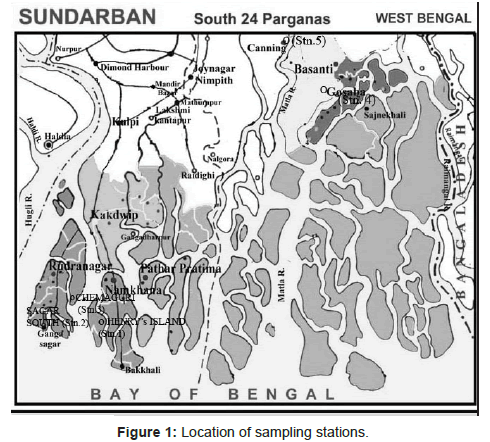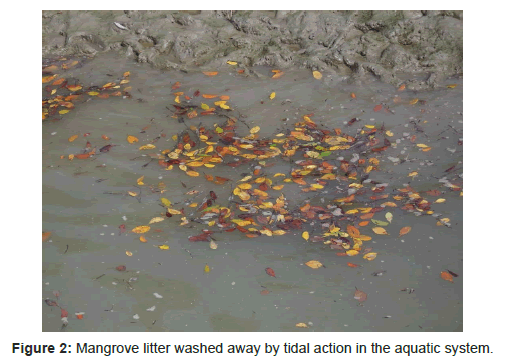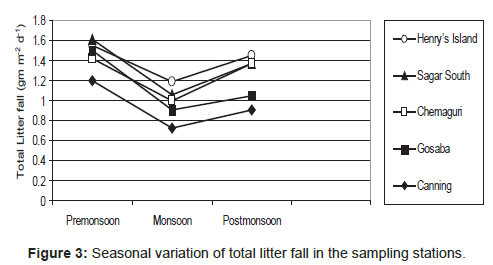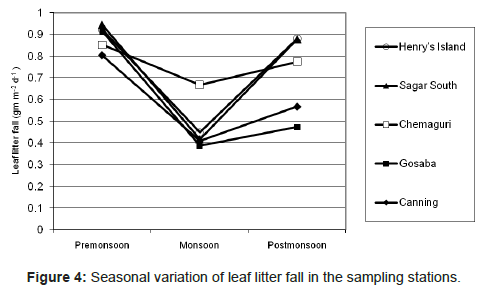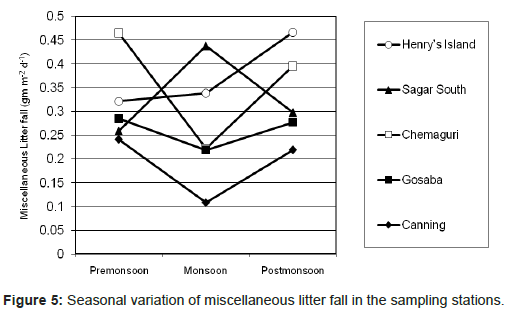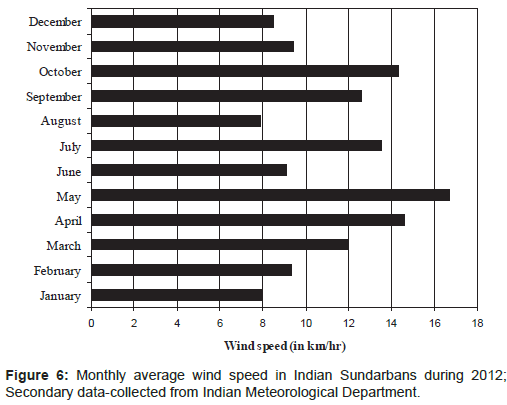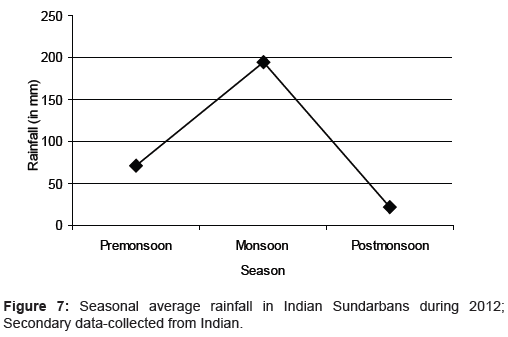Special Issue Article Open Access
Inter-relationship between Physico-chemical Variables and Litter Production in Mangroves of Indian Sundarbans
Rajrupa Ghosh1* and Kakoli Banerjee2
1Techno India University, Salt Lake, Kolkata-700 091, India
2School of Biodiversity and Conservation of Natural Resources, Central University of Orissa, Koraput, India
- *Corresponding Author:
- Rajrupa Ghosh
Techno India University
Salt Lake, Kolkata-700 091, India
Tel: (+968) 2414 3582
E-mail: rajrupa14@gmail.com
Received date: July 25, 2013 Accepted date: October 24, 2013 Published date: October 29, 2013
Citation: Ghosh R, Banerjee K (2013) Inter-relationship between Physico-chemical Variables and Litter Production in Mangroves of Indian Sundarbans.J Marine Sci Res Development S11:001. doi: 10.4172/2155-9910.S11-001
Copyright: © 2012 Ghosh R, et al. This is an open-access article distributed under the terms of the Creative Commons Attribution License, which permits unrestricted use, distribution, and reproduction in any medium, provided the original author and source are credited.
Visit for more related articles at Journal of Marine Science: Research & Development
Abstract
Litter production in mangrove has immense ecological importance, as it sustains both the planktonic and detritus food webs in the aquatic phase and intertidal mudflats, respectively. The present study was undertaken in the western and central sectors of Indian Sundarbans that are different in terms of physico-chemical variables (particularly salinity). Litter production was higher in the western sector owing to higher diversity of mangrove species in the selected plots. High salinity and wind action also accelerated the process of litter fall (both leaf litter and miscellaneous litter), and hence, the peak values of total litter, leaf litter and miscellaneous litter fall (except Sagar Island) was observed in premonsoon season, in both the western and central sectors of the study area.
Keywords
Mangrove litter; Indian Sundarbans; Salinity
Introduction
Mangroves are taxonomically diverse group of salt-tolerant, mainly arboreal, flowering plants that grow primarily in tropical and subtropical regions [1]. A “mangrove” has been defined as a “tree, shrub, palm or ground fern, generally exceeding more than half a meter in height, and which normally grows above mean sea level in the intertidal zones of marine coastal environments or estuarine margins” [2]. The term “mangrove” can refer to either the ecosystem or individual plants [2]. Estimates of mangrove area vary from several million hectares (ha) to 15 million ha worldwide [3,4]. Mangrove ecosystems thrive along coastlines throughout most of the tropics and subtropics. These intertidal forests play important ecological and socioeconomic roles by acting as a nutrient filter between land and sea [5], contributing to coastline protection [6], providing commercial fisheries resources [7], and nursery grounds for coastal fishes and crustaceans. About 60% to 70% of the tropical coasts are covered by mangrove ecosystem. Mangrove vegetations sustain food webs in the adjacent aquatic phase and intertidal mudflats through litter production. Litter production is the shedding of vegetative or reproductive plant structures. Senescence, withering, death and other stresses, such as winds and precipitation govern mangrove litter production. As shown in Figure 3, mangrove litter production can vary from as low as 0.905 gm.m-2 day-1 to as high as 1.605 gm.m-2 day-1, depending on the seasons and physico-chemical conditions of the area. Variability in the production of litter from place to place may be attributed to climatic conditions and other factors, e.g. types of forest, sediment quality and available nutrients for the plant growth. Following litter production, decomposition and mineralization of detritus occurs, thus fertilizing the water in and around the ecosystem with high nutrients. Microorganisms [8], invertebrates [9-11], and fishes [12] have been reported to consume and help in mineralization. Thus, the role of mangrove litter in spinning the estuarine food web is beyond any debate and doubt. Quantification of litter fall through seasons and its relationship with ambient aquatic salinity has not been documented in the eastern part of Indian Sundarbans, although the area is one of the most biologically productive, taxonomically diverse and aesthetically celebrated ecosystems of Indian subcontinent, and is the only mangrove base of the Royal Bengal Tiger (Panthera tigris tigris) in the planet Earth.
In the present study, an attempt has been made to report the seasonal pattern and amount of litter production in mangrove swamps of Indian Sundarbans during 2012. Common physico-chemical variables like surface water temperature, salinity, pH, dissolved oxygen, wind speed and rainfall were also analysed and collected from secondary source (Indian Meteorological Department), simultaneously to determine the influence of these variables on litter production.
Materials and Methods
Study area
The Indian Sundarbans, a Gangetic delta at the apex of Bay of Bengal, has an area of 9630 sq. km and houses 102 islands. The western sector of the deltaic lobe receives the snowmelt water of mighty Himalayan glaciers after being regulated through several barrages on the way. The central sector, on the other hand, is fully deprived from such supply due to heavy siltation and clogging of the Bidyadhari channel in the late 15th century. The contrasting physical set up has made the mangrove ecosystem of Indian Sundarbans, an interesting study zone in terms of physico-chemical variables, which have great role in the growth and survival of mangrove species. Accordingly, our sampling stations were selected in the western and central sectors of Indian Sundarbans (Figure 1 and Table 1), primarily on the basis of salinity.
| Station | Coordinates | Salient Features |
|---|---|---|
| Henry’s Island (Stn.1) | 88° 15Î� 24" E 21° 45Î� 24" N |
Faces River Muriganga, which is a branch of Hugli River; located in the western sector of Indian Sundarbans. |
| Sagar South (Stn.2) | 88° 01Î� 47" E 21° 39Î� 04" N |
Situated at the confluence of River Hugli and Bay of Bengal on the western sector of Indian Sundarbans. |
| Chemaguri (Stn.3) | 88° 09Î� 11" E 21° 39Î� 49" N |
Located in the western part of Indian Sundarbans and faces River Muriganga on the eastern side. |
| Gosaba (Stn. 4) | 88° 39Î� 46" E 22° 15Î� 45" N |
Located in the Matla Riverine stretch in the central sector of Indian Sundarbans. |
| Canning (Stn.5) | 88° 40Î� 36" E 22° 18Î� 37" N |
Located in the upstream of River Matla in the central sector of Indian Sundarbans |
Table 1: Sampling stations with coordinates and salient features.
Litter fall and physico-chemical parameters estimation
Litter fall was determined by setting 2 rectangular traps (3 m×3 m) in all the 5 randomly selected plots (10 m×10 m) in each station. Thus, materials were collected from 10 traps to get a representative picture of each station. The traps were made of 1 mm mesh size nylon screen through which rainwater can pass [13]. They were positioned above the high tide level [14], and contents of all the 10 traps were collected from each of the selected stations and brought to the laboratory in every month during 2012. The collected litter was segregated into leaf litter and miscellaneous litter (comprised of twigs, barks, fruits, stipules etc), dried at 80 ± 5°C, and weighed to get the proportions of major components in the total collections. Finally, the mean weight per plot was estimated and transformed into gm.m-2 day-1 unit.
Hydrological parameters, such as surface water temperature, salinity, pH and dissolved oxygen were analyzed as per the standard methodology outlined in Strickland and Parsons [15]. Data on rainfall and wind speed were collected from the Indian Meteorological Department of nearest monitoring station at Canning.
Results and Discussion
The mangrove ecosystem of Indian Sundarbans sustains 34 true mangrove species and several associates, which nourish the adjacent waterbodies and intertidal mudflats through contribution of litter and detritus. The tidal flushing at regular interval of time washes out the litter from the intertidal mudflats to estuarine systems (Figure 2), which on decomposition produces nutrients (nitrate, phosphate, etc.) that compose the biomass of phytoplankton. The total litter fall pattern in all the sampling stations of the study area exhibited a unique seasonal variation (Figure 3), with highest value during premonsoon (March- June) and lowest during monsoon (July-October). Station wise the litter fall values (mean of three seasons) varied as per the order Henry’s Island (1.392 ± 0.151)>Sagar South (1.343 ± 0.225)>Chemaguri (1.261 ± 0.188)>Gosaba (1.152 ± 0.253)>Canning (0.942 ± 0.198).
Peaks of leaf (Figure 4) and miscellaneous (Figure 5) litter coincided because the flowering season in Sundarbans mangrove is mostly restricted during Premonsoon [16] (Table 2). The total litter fall peak coincided with the period of high wind speed in Indian Sundarbans (Figure 6). Similar pattern of litter production was reported in a number of mangrove studies [17-20]. Leaf production was found to be continuous throughout the study period, which suggests that the environmental conditions are favourable for leaf emergence all year round, and the stress does not appear to limit the leaf production in the present geographical locale which shows that they are evergreen forests. Similar trends were also observed by a number of researchers, while working on the mangrove systems [21,22].
| Flowering period | Species |
|---|---|
| 20th March to 15th April | Aegiceras corniculatum, Acanthus ilicifolius |
| 31st March to 15th April | Phoenix paludosa |
| 5th April to 20th April | Ceriops decandra |
| 1st May to 20th May | Avicennia spp. |
| 20th May to 5th June | Excoecaria agallocha |
| 15th April to 5th May | Sonneratia apetala |
Source: Chaudhuri & Choudhury [16].
Table 2: Peak periods of flowering for different mangrove species of Indian Sundarbans.
In terms of biomass, the total litter fall in the study area ranges from 3.312t ha-1 yr-1 to 5.874 t ha-1 yr-1, which is more or less comparable to other regions of the world. Twilley et al. [17] reported that the total annual litter fall of mixed mangrove forest of Avicennia germinans, Rhizophora mangle and Laguncularia racemosa in South Florida was 8.68 t ha-1 yr-1 (in Fort Myers) and 7.51 t ha-1 yr-1 (at Rookery Bay). Steinke and Charles [22] reported the total annual litter fall of mangrove forest in the Mgeni estuary was 8.61t ha-1 yr-1. Kishimoto et al. [23] reported that the litter fall of mangrove stands on Iriomote Island (Japan), was 7.50 and 8.80 t ha-1 yr-1 in Rhizophora stylosa and Bruguiera gymnorrhiza community, respectively. The annual litter fall across broad geographic boundaries are reported as 7 to 12 t dry weight ha-1 yr-1 by a number of workers [20,24-28]. The litter production in the present study area showed drastic spatial variation with lower values in stations of Central Indian Sundarbans, which may be attributed to lower diversity of mangrove flora in the selected plots in their sector in comparison to western part (Table 3).
| Species | Henry’s Island | Sagar South | Chemaguri | Gosaba | Canning |
|---|---|---|---|---|---|
| Sonneratia apetala | ++ | ++ | ++ | + | + |
| Avicennia alba | ++ | ++ | ++ | ++ | ++ |
| Avicennia marina | ++ | ++ | ++ | ++ | ++ |
| Avicennia officinalis | ++ | ++ | ++ | ++ | ++ |
| Excoecaria agallocha | + | + | ++ | ++ | ++ |
| Bruguiera gymnorrhiza | + | + | + | _ | _ |
| Aegiceros rotundifolia | + | + | + | _ | _ |
| Ceriops tagal | + | + | + | _ | _ |
++ Highly abundant; + available; - absent
Table 3: Composition of mangrove flora in the selected stations.
The physico-chemical variables of the sampling stations (Table 4) seem to exert a regulatory influence on mangrove litter production in the present geographical locale. Significant positive correlations of litter fall rate with wind velocity (r=0.597; p<0.05), and salinity (r=0.699; p<0.01) were observed, which confirm the premonsoon season as the peak season of litter fall in the study area. The premonsoon season in this part of the subcontinent is characterized by Nor’westers and occasional torrential rain (Figure 7), which induce the falling of leaves, flowers and fruits and breaking of twigs contributing to total litter production. High surface water temperature and salinity accelerate litter fall by posing physiological stress to mangrove species, as stated by several researchers [29,30].
| Month | Season | Surface water temperature (°C) | Surface water salinity (‰) | Surface water pH | DO (ppm) | Total litter g/m2/day |
|---|---|---|---|---|---|---|
| Henry’s Island | Premonsoon | 34.0 | 26.08 | 8.30 | 4.56 | 1.544 |
| Monsoon | 32.9 | 10.02 | 8.05 | 5.98 | 1.186 | |
| Postmonsoon | 29.9 | 20.10 | 8.10 | 5.13 | 1.447 | |
| Sagar South | Premonsoon | 34.0 | 24.15 | 8.28 | 4.55 | 1.605 |
| Monsoon | 32.8 | 9.66 | 8.00 | 4.02 | 1.055 | |
| Postmonsoon | 29.8 | 18.50 | 8.10 | 4.85 | 1.368 | |
| Chemaguri | Premonsoon | 33.7 | 21.80 | 8.28 | 5.13 | 1.417 |
| Monsoon | 32.5 | 6.59 | 7.99 | 5.81 | 0.996 | |
| Postmonsoon | 28.0 | 12.48 | 8.04 | 4.93 | 1.370 | |
| Gosaba | Premonsoon | 33.6 | 22.40 | 8.10 | 4.68 | 1.500 |
| Monsoon | 32.6 | 12.68 | 7.95 | 4.93 | 0.905 | |
| Postmonsoon | 29.6 | 19.59 | 8.00 | 5.01 | 1.050 | |
| Canning | Premonsoon | 33.8 | 22.01 | 8.10 | 4.85 | 1.200 |
| Monsoon | 32.6 | 9.23 | 7.80 | 5.76 | 0.719 | |
| Postmonsoon | 28.9 | 18.45 | 7.90 | 5.32 | 0.908 |
Table 4: Monthly variation of physico-chemical variables at the sampling stations.
Litter production in mangrove system and its transportation to adjacent waterbodies by tidal action has immense ecological importance, in terms of sustenance of both detritus and planktonic food webs. Quantification of litter biomass through season is, therefore necessary to understand the magnitude of energy flow through various members of the trophic level in the Sundarbans mangrove ecosystem.
References
- Ellison JC, Stoddart DR (1991) Mangrove ecosystem collapse during predicted sea-level rise Holocene analogues and implications. J Coastal Res 7: 151-165.
- Duke NC (1992) Mangrove floristics and biogeography. In: Robertson AI, Alongi DM (Ed.), Tropical Mangrove Ecosystems. American Geophysical Union, Washington DC, USA 63-100.
- Tomlinson PB (1986) The botany of mangroves. Cambridge University Press, UK.
- FAO and UNEP (1981) Los Recursos Forestales de la America Tropical Proyecto de Evaluación de los Recursos Forestales Tropicales (en el marco de SINUVIMA). FAO, UNEP, Rome 349.
- Robertson AI, Phillips MJ (1995) Mangroves as filters of shrimp pond effluent Prediction and biogeochemical research needs. Hydrobiolgia 295: 311-321.
- Vermatt JE, Thampanya U (2006) Mangroves mitigate tsunami damage: A further response. Estuar Coast Shelf Sci 69: 1-3.
- Robert Costanza, Ralph d’Arge, Rudolf de Groot, Stephen Farberk, Monica Grasso, et al. (1997) The value of the world’s ecosystem service and natural capital. Nature 387: 253-259.
- Chirstensen B (1978) Biomass and primary production of Rhizophora apiculata in a mangrove in southern Thailand. Aquat Bot 4: 43-52.
- Malley DF (1977) Adaptations of decapod crustaceans to life in mangrove swamps. Mar Res Indonesia 18: 63-72.
- Odum WE, Heald EJ (1972) Trophic analyses of an estuarine mangrove community Bull Mar Sci 22: 671-738.
- Odum WE, Heald EJ (1975) Mangrove forest and aquatic productivity. Coupling of Land and Water Systems: Ecological Studies 10: 129-136.
- Macintosh DJ (1982) Fisheries and aquaculture significance of mangrove swamps, with special reference to the Indo-Western Pacific region. In: Muir J, Roberts R (Ed.), Recent advance in aquaculture, Croom Helm Ltd., London, UK 4-85.
- Brown MS (1984) Mangrove litter production and dynamics. In: Snedaker CS, Snedaker JS (Ed.), The mangrove ecosystem: Research methods monograph on oceanographic methodology. UNESCO 231-238.
- Jeffrie F Mokolengsang, Tokuyama A (1998) Litter production of mangrove forests at the Gesashi River. Bull Coll Sci University of the Ryukyus 65: 73-79.
- Strickland JDH, Parsons TR (1972) A practical handbook of seawater analysis. Fish Res Board of Canada 310.
- Chaudhuri AB, Choudhury A (1994) Mangroves of the Sundarbans, India. Vol. 1, IUCN, India.
- Twilley R, Lugo AE, Zucca CP (1986) Litter production and turnover in basin mangrove forest in South-West Florida. Ecol 67: 670-683.
- Day JR, Conner WH, Ley-Lou F, Day RH, Machado A (1988) Productivity and composition of mangrove forests at Boca Chica and Estero pargo. In: Yanez-Arancibia A, Jr Day JW (Ed.), Ecology of coastal ecosystems in the southern Gulf of Mexico: The terminus lagoon region. Universidad Nacional Autonoma de Mexico. Organization de los Estados Americanos 237-257.
- Amarasinghe MD, Balasubramaniam S (1992) Net primary production of two mangrove forest stands on North-western coast of Sri Lanka. Hydrobiol 247: 37-47.
- Mmochi AJ (1993) Ecology of mangrove ecosystem: Role of mangrove in dissolved inorganic nutrient fluxes, sediment budgets and litter supplies to Gesashi Bay, Higashi Village. Thesis of Master of Science, Coll Sci University of the Ryukyus, Okinawa, Japan 82.
- Wium-Andersen S, Christensen B (1978) Seasonal growth of mangrove trees in Southern Thailand. I. The phenology of Rhizophora apiculata Bl. Aquat Bot 3: 281-286.
- Steinke TD, Charles LM (1984) Productivity and phenology of Avicennia marina and Bruguiera gymnorrhiza in Mgeni estuary, South Africa. Physiology and Management of mangroves 9: 25-36.
- Kishimoto T, Miyajima T, Nakasuga T, Baba S (1987) Zonation of Mangrove forest (III) litter fall and its seasonal change. Trans MtgJap For Soc 98: 301-302.
- Duke NC, Bunt JS, Williams WT (1981) Mangrove litter fall in north-eastern Australia (I) annual totals by component in selected species. Aust Jr Bot 29: 547-553.
- Hardiwinoto S, Nakasuga T, Igarashi T (1989) Litter production and decomposition of mangrove forest at Ohura Bay, Okinawa. Res Bull Coll Expt46: 577-594.
- Lee YS (1990) Primary productivity and particulate organic matter flow in an estuarine a mangrove wetland in Hongkong. Mar Ecol 106: 453-463.
- Gong WK, Ong JE (1990) Plant biomass and nutrient flux in a managed mangrove forest in Malaysia, Estuar Coast Shelf Sci 31: 519-530.
- Mall L, Singh VP, Garge A (1991) Study of biomass, litter fall, litter decomposition and soil respiration monogeneric and mixed mangrove forests of Andaman Island. Trop Ecol 32: 235-249.
- Blasco F (1984) Climatic factors and the biology of mangrove plants. In: CS Snedaker & JS Snedaker, editors.The mangrove ecosystem: research methods. UNESCO.
- Mitra A, Banerjee K, Bhattacharyya DP (2004) In: The other Face of Mangroves Department of Environment, Govt of West Bengal, India.
Relevant Topics
- Algal Blooms
- Blue Carbon Sequestration
- Brackish Water
- Catfish
- Coral Bleaching
- Coral Reefs
- Deep Sea Fish
- Deep Sea Mining
- Ichthyoplankton
- Mangrove Ecosystem
- Marine Engineering
- Marine Fisheries
- Marine Mammal Research
- Marine Microbiome Analysis
- Marine Pollution
- Marine Reptiles
- Marine Science
- Ocean Currents
- Photoendosymbiosis
- Reef Biology
- Sea Food
- Sea Grass
- Sea Transportation
- Seaweed
Recommended Journals
Article Tools
Article Usage
- Total views: 15325
- [From(publication date):
specialissue-2014 - Nov 27, 2025] - Breakdown by view type
- HTML page views : 10521
- PDF downloads : 4804

